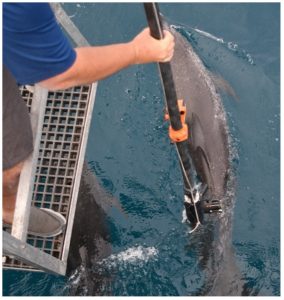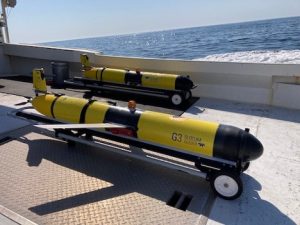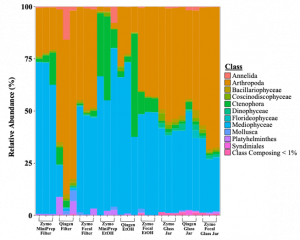CINAR Research Themes
Highlights for Theme IV: Protected Species Research and Recovery
Assessment of Movement Patterns and Critical Habitat for Coastal and Continental Shelf Small Cetaceans in the Gulf of Mexico using Newly Developed Remote Satellite Tagging Techniques, PI Michael Moore, WHOI
The objectives of this project are (1) to develop a new and innovative tool to remotely attach telemetry devices to monitor the movement, behavior, and habitat use of coastal and continental shelf small cetaceans; and (2) to deploy satellite-linked tags remotely on free-swimming small cetaceans in the coastal and continental shelf waters of the Gulf of Mexico to facilitate safe collection of data on movements and critical habitats for these species that can be used to inform management agencies on appropriate management and restoration strategies. This project builds off research efforts conducted under a previous NOAA RESTORE Science Program grant to the National Marine Mammal Foundation (NMMF), as well as prior collaborative efforts by Sarasota Dolphin Research Program (SDRP) and WHOI. Both prior efforts developed and tested various approaches for a remote tag attachment device, and both converged on a prototype design using a pole and pneumatic device for tag attachment. The current version of the pole-mounted Tag Attachment Device (TADpole) prototype developed by the SDRP-WHOI team was the starting point for this project.
Figure 1: TADpole being positioned around the dorsal fin of an Atlantic spotted before tag deployment.
 
Developing Acoustic Interoperability Open Standards for On-Demand Fishing, PI Mark Baumgartner, WHOI
Passive acoustic monitoring is a vital part of NMFS’ mission to assess and manage marine mammal stocks, since it provides a persistent and cost-effective complement to more traditional monitoring approaches (i.e., shipboard and aerial surveys). Recent advances in automated detection and classification techniques for low-frequency baleen whale calls have made determining occurrence in real-time from in-situ acoustic instrumentation feasible. We have developed the capability to remotely detect and report a wide variety of calls produced by several species of baleen whales from autonomous platforms, including Slocum ocean gliders, wave gliders, and moored buoys. The enabling technology for this project is the digital acoustic monitoring (DMON) instrument and the low-frequency detection and classification system (LFDCS) -- a combined hardware (DMON) and software (LFDCS) system capable of detecting and reporting low-frequency narrowband sounds in real time. The DMON instrument collects, conditions, processes, and records audio from up to three attached hydrophones, and since it is programmable, applications can be developed to detect, classify, and report sounds from the collected audio in real time. The LFDCS is software that detects and describes sounds using pitch tracking, and classifies those sounds using quadratic discriminant function analysis.
The combined DMON/LFDCS has been integrated with several autonomous platforms. For this project, we (1) use the DMON/LFDCS on Slocum gliders to monitor and study the occurrence and distribution of whales and commercially important fish, and (2) contribute near real-time detections of the highly endangered North Atlantic right whale to NOAA for use in the Slow Zones program, which asks mariners to slow to 10 knots or less in areas where right whales have been detected. We have been able to significantly enhance NMFS’ research and monitoring efforts using real-time detection information to identify areas of persistent animal (whale and fish) occurrence, and to aid in the management and conservation of North Atlantic right whales by contributing to the Slow Zones program.
Figure 2: The Slocum glider that conducted a survey in the central Gulf of Maine equipped with a conductivity-temperature-depth instrument, chlorophyll fluorometer and turbidity instrument and the DMON passive acoustic monitoring instrument.
URI-CINAR: URI-CINAR: Right whale feeding ecology and habitat usage, PI Tatiana Rynearson, URI
Studies on the endangered North Atlantic right whale have shown that the whales dive to and feed in extremely dense aggregations of their primary food source, the copepod Calanus finmarchicus. NOAA observations indicate that right whales also exhibit feeding behaviors when their primary food source does not appear to be either present in the water column or present but not in energy-rich life stages.
This research aims to (1) complete an existing pilot CINAR project aimed at using fecal DNA (fDNA) to understand right whale diet composition during seasons or in habitats that do not support dense aggregations of late juvenile and adult Calanus, (2) examine the feasibility of using eDNA to identify the presence of Calanus and other food sources in areas where right whales forage, and (3) conduct DNA fingerprinting of right whale scat samples archived at the New England Aquarium to connect fecal material to diet composition and to specific whales in the right whale catalog. Our long-term goal to better understand right whale feeding ecology is tightly linked to the aim of developing data-driven conservation approaches for this endangered species.



